Understanding fish to better protect them
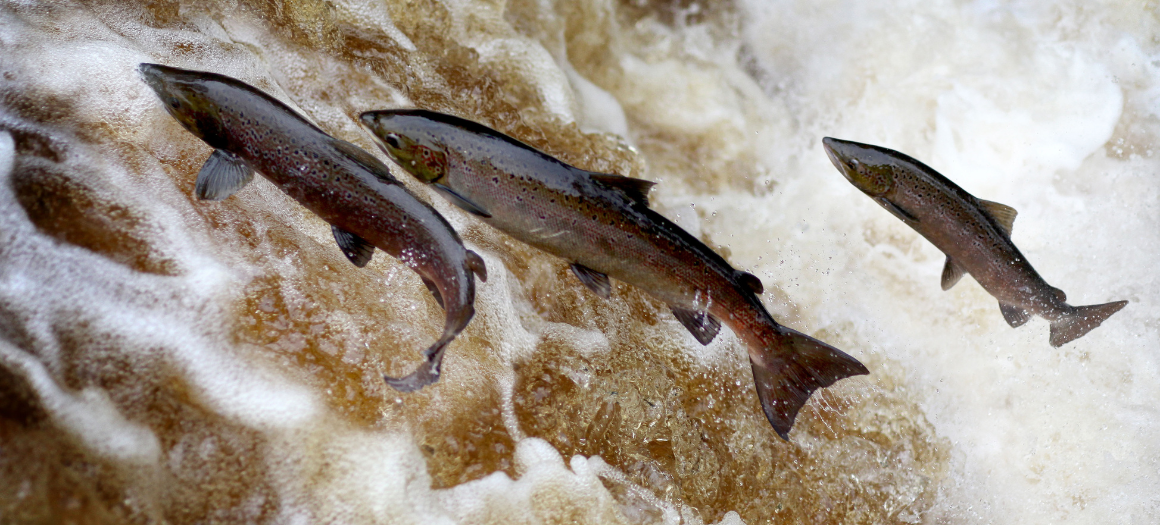
Here at WildFish, we spend a lot of time thinking about fish. We follow all the latest research about how they live their lives, the challenges they face, and all the amazing things they can do.
But, after a lifetime of studying fish, the renowned evolutionary biologist Stephen Jay Gould said, “I regret to report that there is surely no such thing as a fish”.[1] Despite the rapidly declining populations of some of our most iconic species, such as the Atlantic salmon, I am happy to report that there most definitely is such a thing as a fish! However, as scientists, it is interesting to think about why he made such a provocative statement. So what did he mean?
Our connection to fish
The evolutionary biology of fish is as exciting and diverse as it gets. It is easy to lump together everything with fins and gills and call it a fish, but I think it’s well worth remembering that even within the group of ray-finned fish, a salmon is more distantly related to a sturgeon than a frog is to a crocodile or a hummingbird to a wolf.
Perhaps even more shockingly, it is also true that we are more closely related to a trout or an eel than either of those species is to a shark! The coelacanth is more closely related to us than it is to >99% of other fish, and our friends the lampreys are practically aliens; they split off long ago.
How do biologists classify organisms?
When we think about biological organisms we use the taxonomic classification system. Each organism belongs in a domain, kingdom, phylum, class, order, family, genus and species. Species is the narrowest group and domain is the broadest. The latin name of an organism refers to the genus and then species. For instance the Atlantic salmon, Salmo salar is in the Salmo genus and salar is the species.
All of the members of the species Salmo salar will have a common ancestor. All of the species in the genus Salmo will also have a different common ancestor, further back in evolutionary history. Similarly all the organisms in a particular class will have a common ancestor, and all organisms belonging to each of the three domains will have a common ancestor billions of years ago.
But the category fish doesn’t work like that. When scientists first began classifying animals, all fish were grouped into the class Pices, but with new evidence in the modern phylogenetic classification system that is no longer true. “Fish” is a paraphyletic group, which means that if you look at all the descendants of the last common ancestor of all fish, not all of them are included in the group. There was an original mammal from which all mammals descended, and we descended from it too, so we are mammals. There is also an original fish from which all fish descended, but we descended from that original fish too. Unfortunately though, no matter how much time I spend in the water, I will never be a fish!
Different types of fish
The animals that we think of as fish are also incredibly diverse. There are a few different groups of animals that make up the group we consider to be fish. If we look at a family tree we can see which fish separated off a long time ago, and which fish are closer cousins.
Biologists often separate animals into invertebrates (without a spine) and vertebrates (with a spine). The lancelet, our first branch on the tree above, is a fish-like invertebrate. It is a small swimming animal that looks a lot like a fish, but it is not actually considered to be a fish. It does have the beginnings of a spinal chord, but without the spine to go with it.
When we are talking about evolution it is easy to think of other animals that are represented as branches further back on the evolutionary tree as less evolved than us. This is not true. A lancelet that is alive today is the product of just as much evolutionary time and pressure since our last common ancestor as we are. However, when something works, it is often preserved by evolutionary forces. In studying the lancelets alive today alongside the fossil record and genetic data we can see that there are a lot of things we know about the lancelet as it is now that were also true of our last common ancestor, so we can use it as a model organism to think about what that ancient creature would have been like.
Jawless fish
The earliest kind of true fishes to evolve, around 530 million years ago during the cambrian explosion, were the jawless fish. In the UK we have several species of jawless fish including three kinds of lamprey (brook, river and sea lampreys) and the hagfish. Unsurprisingly, they are called “jawless fish” because they don’t have jaws. All three lamprey species have round, sucking mouths—a bit like a leech—that they use to attach to substrate, while the hagfish has something a bit like a tongue with two horizontal rows of teeth that it can use to grab and pull its food. Mysterious stuff, but it’s working for them!

Cartilaginous fish
Most fish, however, are jawed fish. It turns out that having a jaw is a pretty good strategy for accessing food, because it lets you get a bite in very fast. Jawed fish can be separated into cartilaginous fish and bony fish. Some of our most iconic species are cartilaginous fish, including all the rays, skates and sharks, as well as the mysterious chimaeras. They are called cartilaginous fish because their skeletons are composed of cartilage and not bones. There are many species of cartilaginous fish that are resident in UK waters. We know of at least 21 species of sharks that live in UK waters year round, and there are many more migratory species that regularly stop by for a visit. This includes the basking shark, the second largest living fish in the world and the greenland shark which can live to over 400 years old, making it the longest living vertebrate. Eight of the fifty known species of chimaera have been found in UK waters.[2]
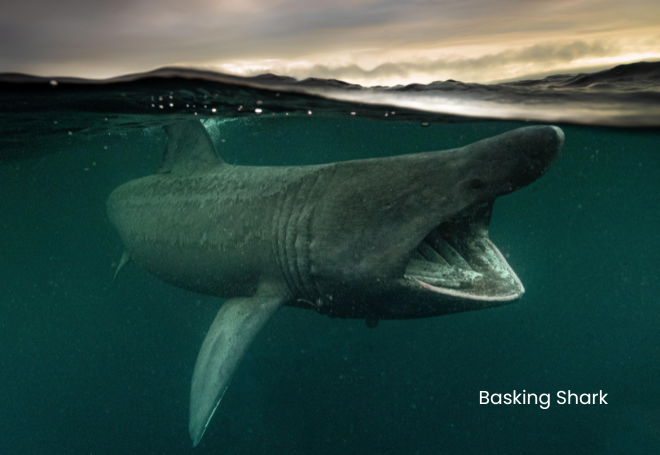
Ray finned fish
By far, the majority of jawed fish are bony fish, and bony fish can be again divided into ray-finned fish and lobe-finned fish. The diversity of ray finned fishes is incredible. Around 96% of currently living fish are ray finned fish, and around 50% of all vertebrates are ray finned fish! This diversity deserves its own deep-dive because there are some magnificent and strange animals in this category, not least the Atlantic salmon and the European eel, which each migrate in opposite directions and undergo totally radical transformations across their lifetimes.
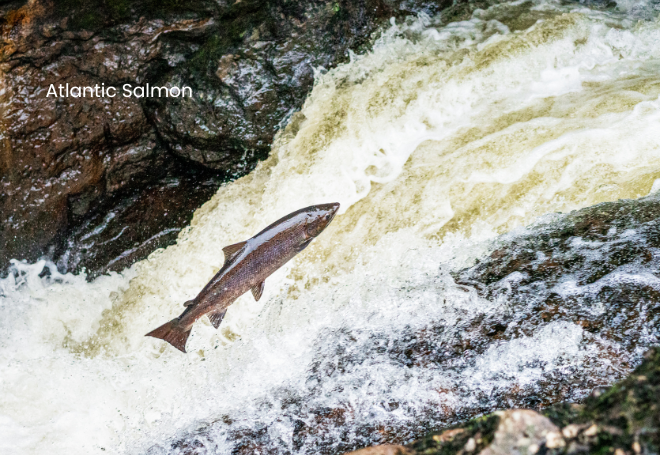
Lobe finned fish
The lobe-finned fishes are our closest cousins still in the sea. They are the fish that are most closely related to tetrapods (all of us for limbed creatures that crawled out onto the land), and while there are no lobe-finned fish living in the UK, you may still have heard of the coelacanths or the lungfishes, the only remaining kinds of lobe finned fish alive today. Lungfish earned their name because they have lungs and can breathe air! They spend much of their life in ephemeral water bodies, and when they dry up the lung fish just keeps going. Perhaps one of the strangest things about the lungfish is that they have an absolutely mammoth volume of DNA, 91 billion base pairs, which is 30x as much as humans. We’re still not sure what they’re doing with it all!
Informed Conservation
British fish face growing pressures – from pollution and habitat loss to the negative impacts of open-net salmon farming and the effects of climate change. Despite their ecological importance, they are often overlooked or misunderstood.
The more we understand fish – how they exist, adapt and interact with their environment (and us) the better equipped we are to protect them. Deepening our understanding also helps us connect with these remarkably complex cousins of ours, worthy of our care and conservation.
Isn’t it time that we saw fish as more than just a resource and started valuing them as a vital part of our living world?
List of References
1. 1981 July, Natural History, Volume 90, Number 7, This View of Life: What, if Anything, Is a Zebra? by Stephen Jay Gould, Start Page 6, Quote Page 12, Column 1, The American Museum of Natural History, New York.
2. https://www.sharktrust.org/chimaera


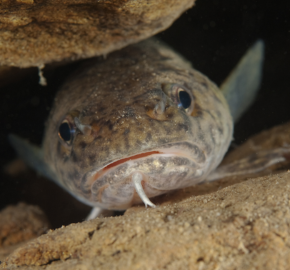
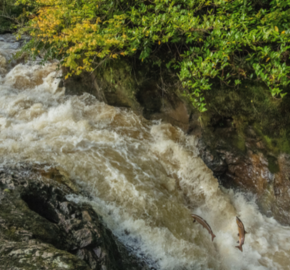
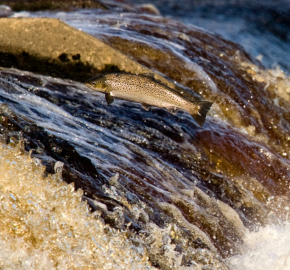
Thanks. A very informative article.
I also found the “What, if anything,is a zebra” quite fascinating. More so because I once wrote a blog article entitled “How Big is a Zebra”, which coincidentally was also aimed at fish: Unlike zebras, it is rather difficult to ask “how big is a trout, or a roach etc”. Fish grow to sizes based more on their environment than on their species.
It’s a mess!
Herbicides, pesticides accumulate in soils and waterways….their effects continuing long term.
SHEEPDIP…compulsory use x2/annum, all sheep farms. Invented in 50’s, massively enthusiastic use, BY LAW, since, not to mention domestic pet anti-flea/lice/tick chemicals, encouraged, by big pharma and VETS!!!!!
I fear all is lost….where are the prodigious numbers of grasshoppers of my youth……GONE!!